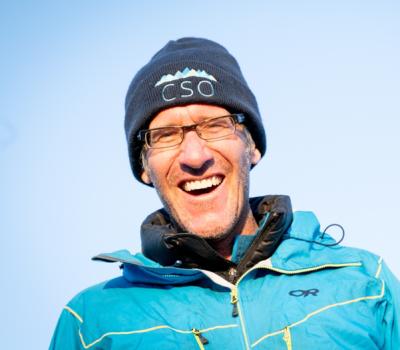Over the past several decades, snowpack throughout the American West has declined precipitously, with more than 90% of the region’s snow-monitoring sites showing significant drop-offs. Altogether, scientists at Oregon State University estimate the shortfall of snow in the West since 1955 at 25 to 50 cubic kilometers of water, a volume roughly the size of Lake Mead.

scientists into models of snowpack that are useful for recreational users,
scientists, and land and watershed managers.
Hill sees snow as a reservoir, akin to a lake, holding back water for use later in the year. “Knowing how much water you have in a surface reservoir like Green Lake or Foster Lake is really easy,” Hill said. “Knowing how much water you have distributed as snowpack is much more difficult because it’s so spread out and so variable. There’s a need to take a lot of measurements so that we have a better idea of how much water equivalent is out there.”
To address this need, NASA’s Citizen Science for Earth Systems Project enlisted Hill, members of his lab, and colleagues at other institutions to launch Community Snow Observations in 2017 for recruiting members of the public to collect snowpack data. Hill and his team then incorporate the data into computer models to generate estimates of snowpack and other information useful for recreational users, scientists, engineers, and land and watershed managers.
“It’s expensive to rely on government facilities to measure all that snow, so you can collect data in only so many places,” Hill said. “But people are out recreating in the snow all the time. Asking them to take a little bit of their time to collect and submit snow measurements gives us information about snowpacks across many different places at many different times.”
Led by Hill, who was designated a National Geographic Explorer in 2019, the first CSO project focused on Alaskan snowpacks. Researchers have since recruited community scientists in the Pacific Northwest and Rocky Mountains regions and across the globe.
A smartphone and an avalanche probe with graduated markings in centimeters (or a meter stick) are the only tools needed. As community scientists make their way through the mountains, they use their probes to take snow depth readings, which they upload using an app on their phone.
As of fall 2022, more than 3,500 unique participants have logged 29,000 observations.
“We’re seeing that community scientists are giving us data at higher elevations in more complex terrain and on steeper slopes than the snow monitoring station network,” said graduate student Christina Aragon. “These data are definitely filling in gaps across the landscape where we typically don’t have many observations.”
Both Hill and Aragon do their part to fill in those gaps when they’re out recreating. Hill likes to take measurements on ski tours near Santiam Pass, while Aragon collects data when she’s snowboarding in remote mountains. “It’s fun to see those spots show up on the map later,” she said.
In recently published research, Hill and his colleagues showed that snowpack models for the Thompson Pass region of Alaska’s Chugach Mountains improved by 62% to 78%, depending on the year, when community science measurements were incorporated.
The team’s snow models are updated daily with CSO data on mountainsnow.org.
“We serve up 25- to 100-meter grids on snow information at many sites across the United States, including the Central Cascades and Mount Hood in Oregon,” Hill said. “The general public can go there and view real-time snow changes as well as snow data coming in from multiple satellites.”
Although the models reveal disturbing trends in snow seasons in the Oregon Cascades and beyond, Hill says the future is still in our hands. “Whether things continue to get worse largely depends on the decisions that we end up making as a society today,” he said.
A few years ago, Hill’s work with Community Snow Observations caught the interest of Protect Our Winters, a community of athletes, scientists, creatives, and business leaders advancing nonpartisan climate policies to protect the world for future generations. Aragon serves as captain of the group’s Science Alliance team, whose mission is helping the community’s members understand and communicate scientific information to the public.
“The goal is getting passionate outdoor people involved in advocating for policies that protect the places and lifestyles that they love,” Aragon said.
For his part, Hill has given public lectures with winter sports athletes explaining climate science and participated in meetings with legislators across Oregon. “The fact that there are people activated and willing to make those things happen is exciting to me,” he said. “Looking forward, I hope to see people continue to be involved and also to hear new voices in these conversations that have been underrepresented in the past.”

